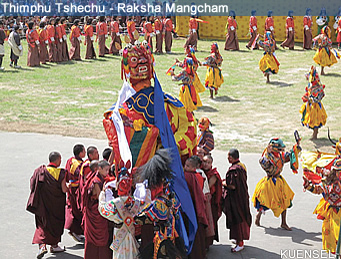| Bhutanese
Folk , Drum and Mask Dance |
 |
Bhutan's Culture Traditional Dance |
|
 |
Bhutan Information |
|
|
 |
|
Thimphu Tshechu |
| Raksha Mangcham - Dance of Judgment Day |
 |
 |
|
One of the highlights on day two of the Thimphu tshechu is the Raksha Mangcham, which portrays the full trial system after death in the court of the Lord of the death.
The dance, which last four to five hours, portrays Shinje Chhogyel (Lord of Death), Lha Karpo (white god) and Dreynakchung (black demon) as the three main dancers.
The three of them are said to be representations of the Rigsum GonpoJampelyang, Chenrizig and Chana Dorji respectively.
|
|
Shinje Chhogyel is the lord of death.He has a fearful crimson face with three eyes.He carries a thramshing in his right hand that signals who is dead from the world, and a mirror in the left that shows what good and bad the deceased has done as a human being.
To his right is the Lhakarpo.He is completely white and holds a rosary in the left hand.In his right hand, he carries white counting stones that weigh the good work done by the person when alive.
To his left is the fearful character with three bulging eyes and a scary sight to children.He is a tall, dark figure dressed completely in black, with a big black mask and a yak tail sticking out from the top.
The Dreynachung (black demon) at every tshechu is a welcome change, after a marathon of mask dances and atsaras entertaining the crowd.But the Draynachung is not just there to silence crying children.Its significance during the raksha mangcham (dance of rakshas and the judgment of the dead) goes beyond life.
When a person is born, he comes with a god and a demon that rest on the two shoulders.From the first day, they record how much sin one commits or merit one earns in a lifetime.
The raksha mangcham dance, which contains more elements of a drama than dance, shows how a person, who has died and is in the state of bardo (intermediate state), is judged for the sins and merits accumulated in a lifetime.
The Dreynachung represents the modern day prosecutor of the dead.He represents the evil, and his attire and mask remind people of the fate of committing sins.
The Raksha, an ox-headed dancer, who represents the head of the persecution committee and the justice minister, leads the dance.He is followed by the monkey, who weighs the sins of the deceased.Next comes the pig, who on viewing the thramshing, goes in search of the deceased together with the garuda, lion, bear, and snake.
The dance portrays the typical case of two personalities: the sinner (Nyelwabum) and the virtuous man (Chimdapelkye).The sinner is sent to the hell and the good doer to the heaven.
Watching the dance brings everyone to the reality of life after death.
| This
article was contributed by Tashi Phuntsho, KUENSEL, Bhutan's National Newspaper
2012 |
 |
top
| Information on Bhutan |
 |
|




